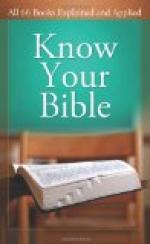For Study and Discussion. (1) Point out elements of strength in the character and work of Nehemiah. (2) The greatness and difficulty of Nehemiah’s task, (a) the rubbish, (b) the size and length of the wall, (c) the strength of their enemies. (3) The reforms of Nehemiah, (a) religious, (b) moral, (c) political. (4) The public meeting and new festival, 8:1-18. (5) The covenant 9:1-10:39. (6) The repeopling of Jerusalem, Chs. 11-12.
Name. This is taken from its principal character, a Jewish maiden became queen of a Persian King.
Purpose. To explain the origin of the feast of Purim work of providence for God’s people.
Time. The events narrated are thought to have occurred about 56 years after the first return of Zerubbabel in 536 B. C. The King then would be Xerxes the Great, and the drunken feast may have been preparatory to the invasion of Greece in the third year of his reign. Connection with Other Books. There is no connection between Esther and the other books of the Bible. While it is a story of the time when the Jews were returning to Jerusalem, and very likely should come between the first and second return, and, therefore, between the sixth and seventh chapters of Ezra, the incident stands alone. Without it we would lose much of our knowledge of that period.
The Story. While Esther stands out as the principal character, the whole story turns on the refusal of Mordecai to bow down to Haman, which would have been to show him divine honor. He did not hate Haman but, as a Jew could not worship any other than God. He dared to stand for principle at the risk of his life.
The Name of God. One of the peculiarities of the book is that it nowhere mentions the name of God, or makes any reference to him. This may be because his name was held secret and sacred at that time. However, God’s power and His care of His people are everywhere implied in the book.
Analysis
I. Esther Made Queen, Chs. 1-2.
1. Queen Vashti dethroned. Ch. 1.
2. Esther made queen. Ch. 2.
II. Haman’s Plot and its Defeat. Chs. 3-8.
1. Haman plots the destruction of the Jews. Ch. 3.
2. The Jews’ mourning and Mordecai’s plea to Esther. Ch. 4.
3. Esther banquets Haman and the King, Ch. 5.
4. Mordecai highly honored for former service. Ch. 6.
5. Esther’s plea granted and Haman hanged, Ch. 7,
6. The Jews allowed defense and Mordecai advanced, Ch. 8.
III. The Jews’ Deliverance, Chs. 9-10.
1. Their enemies slain, 9:1-16.
2. A memorial feast is established. 9:17-32 end.
3. Mordecai made great, Ch. 10.
For Study and Discussion. (1) The character of the king, Vashti, Mordecai, Esther and Haman. (2) Mordecai’s plea to Esther. (3) The honor of Mordecai and humiliation of Haman, Ch. 6. (4) The destruction of their enemies. (5) The feast of Purim, 9:17-32. (6) Truth about God seen in this book. (7) Why not name the book Mordecai or Vashti-are they not as heroic as Esther? (8) The race devotion of the Jews, then and now. (9) Persian life as seen in the book.




